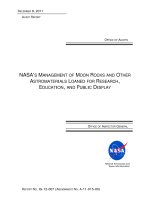bones, rocks and stars
Bạn đang xem bản rút gọn của tài liệu. Xem và tải ngay bản đầy đủ của tài liệu tại đây (967.37 KB, 197 trang )
BONES, ROCKS AND
STARS
The Science of When Things Happened
CHRIS TURNEY
macmillanscience e-book
BONES, ROCKS AND STARS
14039_85995_01_prels 2/3/06 14:22 Page i
This page intentionally left blank
BONES, ROCKS
AND STARS
The Science of When Things Happened
Chris Turney
Macmillan
London New York Melbourne Hong Kong
14039_85995_01_prels 2/3/06 14:22 Page iii
© Chris Turney 2006
All rights reserved. No reproduction, copy or transmission of this publication
may be made without written permission.
No paragraph of this publication may be reproduced, copied or transmitted
save with written permission or in accordance with the provisions of the
Copyright, Designs and Patents Act 1988, or under the terms of any licence
permitting limited copying issued by the Copyright Licensing Agency, 90
Tottenham Court Road, London W1T 4LP.
Any person who does any unauthorised act in relation to this publication
may be liable to criminal prosecution and civil claims for damages.
The author has asserted his right to be identified as the author of this work
in accordance with the Copyright, Designs and Patents Act 1988.
First published 2006 by
Macmillan
Houndmills, Basingstoke, Hampshire RG21 6XS and
175 Fifth Avenue, New York, N.Y. 10010
Companies and representatives throughout the world
ISBN-13: 978–1–4039–8599–6
ISBN-10: 1–4039–8599–5
This book is printed on paper suitable for recycling and made from fully
managed and sustained forest sources.
A catalogue record for this book is available from the British Library.
A catalog record for this book is available from the Library of Congress.
10987654321
15 14 13 12 11 10 09 08 07 06
Printed and bound in China
14039_85995_01_prels 2/3/06 14:22 Page iv
To Annette, my ever-patient wife
14039_85995_01_prels 2/3/06 14:22 Page v
This page intentionally left blank
CONTENTS
List of figures and tables viii
List of permissions and figure sources ix
Acknowledgements xi
Introduction 1
1 The ever-changing calendar 5
2 A hero in a dark age 12
3 The forged cloth of Turin 30
4 The pyramids and the bear’s groin 46
5 The volcano that shook Europe 62
6 The Mandate from Heaven 77
7 The coming of the ice 88
8 The lost worlds 104
9 And then there was one 119
10 The hole in the ground 135
11 Towards the limits of time 146
Epilogue: Time’s up for creationism 159
Further reading 168
Index 176
vii
14039_85995_01_prels 2/3/06 14:22 Page vii
LIST OF FIGURES AND TABLES
Figures
3.1 Radiocarbon formation and movement in
the environment 36
3.2 The decay curve for radiocarbon 38
3.3 The normal distribution 40
4.1 The ‘wobble’ in the Earth’s rotation causes the
precession of the equinoxes 55
4.2 Making the alignment for the Great Pyramid of
Khufu against Mizar and Kochab in 2478
BC 57
4.3 Dating the Egyptian pyramids of the Fourth and
Fifth Dynasties 60
5.1 Using radiocarbon wiggles to date the Santorini
eruption 74
6.1 Oak ring patterns for trees growing during the
1628
BC event at Garry Bog, Northern Ireland 81
7.1 The different controls on the Earth’s orbit around
the Sun 94
7.2 Changing ice volume and solar radiation for the
past 600,000 years 100
7.3 Temperature changes in Greenland over the
past 90,000 years 102
Tables
2.1 Key sources, events and dates for the Arthurian
period 21
2.2 Best-guess dates of key events for the Arthurian
period 23
viii
14039_85995_01_prels 2/3/06 14:22 Page viii
ix
LIST OF PERMISSIONS AND
FIGURE SOURCES
Figure 4.3 entitled ‘Dating the Egyptian pyramids of the
Fourth and Fifth Dynasties’ came from, Spence, K. (2000)
Ancient Egyptian chronology and the astronomical orienta-
tion of pyramids, Nature, 408, 320–4.
The data used to plot part of the radiocarbon calibration
curve used in Figure 5.1 ‘Using radiocarbon wiggles to date
the Santorini eruption’ came from Reimer, P.J., Baillie,
M.G.L., Bard, E., Bayliss, A., Beck, J.W., Bertrand, C.J.H.,
Blackwell, P.G., Buck, C.E., Burr, G.S., Cutler, K.B.,
Damon, P.E., Edwards, R.L., Fairbanks, R.G., Friedrich, M.,
Guilderson, T.P., Hogg, A.G., Hughen, K.A. and Kromer, B.
(2004) IntCal04 terrestrial radiocarbon age calibration, 0-
26 cal kyr BP. Radiocarbon, 46, 1029–58.
The data used to plot Figure 7.2 ‘Changing ice volume and
solar radiation for the past 600,000 years’ came from Berger,
A. and Loutre, M.F. (1991) Insolation values for the climate
of the last 10 million years. Quaternary Science Reviews, 10,
297–318 and Imbrie, J., Shackleton, N.J., Pisias, N.G., Morley,
J.J., Prell, W.L., Martinson, D.G., Hayes, J.D., MacIntyre, A.
and Mix, A.C. (1984) The orbital theory of Pleistocene
climate: support from a revised chronology of the marine
δ
18
O record. In: Milankovitch and Climate, Part 1, Ed. by A.
Berger, Reidel, Hingham, Massachusetts, 269–305.
The data used to plot Figure 7.3 ‘Temperature changes in
Greenland over the past 90,000 years’ came from Blunier, T.
and Brook, E.J. (2001) Timing of millennial-scale climate
change in Antarctica and Greenland during the last glacial
period. Science, 291, 109–12.
Many thanks to Mike Baillie for permission to reproduce the
illustration in Figure 6.1 entitled ‘Oak ring patterns for trees
14039_85995_01_prels 2/3/06 14:22 Page ix
growing during the 1628 BC event at Garry Bog, Northern
Ireland’. This figure was modified from that published in
Baillie, M. (2000) Exodus to Arthur, Batsford, London.
Every effort has been made to trace all the copyright holders
but if any have been inadvertently overlooked the publishers
will be pleased to make the necessary arrangements at the first
opportunity.
x LIST OF PERMISSIONS AND FIGURE SOURCES
14039_85995_01_prels 2/3/06 14:22 Page x
ACKNOWLEDGEMENTS
In writing this book, I owe a great deal to the numerous texts
listed under Further Reading. In addition, I am grateful to the
many students, colleagues and friends I have had the pleasure
of working with over the years. I would particularly like to
thank the following individuals: Julian Andrews, Fachroel
Aziz, Mike Baillie, Tim Barrows, Mike Benton, Michael Bird,
Nick Branch, George Burton, John Chappell, Steve Clemens,
Ed Cook, Alan Cooper, Joan Cowley, Margaret Currie, Siwan
Davies, Charlie Dortch, Keith Fifield, Tim Flannery, Mike
Gagan, Rainer Grün, Simon Haberle, Valerie Hall, Doug
Harkness, Christine Hertler, Peter Hill, Doug Hobbs, Alan
Hogg, Stephen Hoper, Mike Hulme, John Hunt, Sigfus
Johnsen, the late Rhys Jones, Bob Kalin, Rob Kemp, Peter
Kershaw, Dikdik Kosasih, Ollie Lavery, Finbar McCormick,
Jim McDonald, Matt McGlone, Giff Miller, Neville Moar,
Mike Morwood, Patrick Moss, Callum Murray, Colin Murray-
Wallace, Jonathan Palmer, Jon Pilcher, Paula Reimer, Yan
Rizal, Bert Roberts, Jim Rose, Richie Sims, Phil Shane, Mike
Smith, Jørgen-Peder Steffenson, Chris Stringer, Djadjang
Sukarna, Thomas Sutikna, Michelle Thompson, Chris
Tomkins, Gert van den Bergh, Mike Walker, Stefan Wastegård
and Janet Wilmshurst. A special thanks to John Lowe at Royal
Holloway, University of London, for his years of inspired and
level-headed professional advice without which I would not be
where I am today. If I have forgotten anyone I am sorry.
I would also like to thank my editor Sara Abdulla at
Macmillan for her guidance and patience in seeing this book
through to the end.
Finally I would like to thank all my family, including my
children Cara and Robert, and my parents Ian and Cathy. I
am beholden to my darling and ever-patient wife, Annette,
without whom this book would never have happened.
xi
14039_85995_01_prels 2/3/06 14:22 Page xi
This page intentionally left blank
1
INTRODUCTION
Time present and time past
Are both perhaps present in time future,
And time future contained in time past
THOMAS STEARNS ELIOT (1888–1965)
Time is one of the greatest of all our obsessions. Why? In
many ways, it’s a complete paradox. After all, time has no
physical basis. We can’t feel or touch it. Yet there’s almost a
sense that we can see it. From as soon as we can remember, we
become aware that ‘time flies’ and ‘time is money’. We relig-
iously follow the movement of the hands on a clock; we allow
time to dictate our lives. And no matter how hard we try,
most of us just don’t have enough of it.
Unfortunately, we really can’t ignore the unrelenting tick of
the clock. Even a hermit living in the back of beyond isn’t
immune to its effects. Surviving the different seasons would
force even the most zealous recluse to follow the demands of
the clock. Regardless of whether it’s a business meeting or the
migration of a school of whales, our world runs on time. We
simply can’t avoid it.
How time is used has always been pretty controversial. The
control of something we both love and hate has often been
seen as a way of wielding power. When the world’s clocks were
set relative to Greenwich Mean Time in 1884, competing
empires offered alternatives. When the modern Gregorian
calendar was developed by the Roman Catholic Church in
1582, it was ignored by Protestant and other religious nations
and resulted in organized chaos for several centuries.
Even what might seem to be a safe discussion on the age of
our universe has got people into trouble. As recently as 2005,
the singer Katie Melua had a top-5 hit single in the UK called
14039_85995_02_int01 2/3/06 13:29 Page 1
‘Nine Million Bicycles’. One of the verses contained the
rather innocent-sounding ‘We are 12 billion light years from
the edge. That’s a guess. No one can ever say it’s true’. We
shall come back to the age of the universe later but for now
let’s just say the scientific community was incensed; this age
was way off the mark. Interviews were had; a flurry of articles
written. An alternative version was created, with the
offending lyrics replaced by the less harmonious-sounding
‘We are 13.7 billion light years from the edge of the observable
universe. That’s a good estimate with well-defined error bars.
Scientists say it’s true, but acknowledge that it may be
refined’. Sometimes science and the arts just don’t mix.
Fundamentally, we love to know how old things are. Every
other day an article appears in a newspaper, on the web or on
television, telling us that an archaeological or geological find
has been discovered and it’s ‘x years old’. Big numbers are
impressive, so ages regularly get top billing in the press. They
grab the imagination. It almost seems that the further back in
the past the better. But with this comes quite a bit of confusion.
Although the example of Katie Melua and the age of the
universe is a pretty small spat in the grand scheme of things,
there is a difference of 1.7 billion years between the ages
according to the lyrics and science. That’s a heck of a long time.
During my scientific career, I’ve been fascinated by the past
and communicating its importance but it does seem that
there is an ever-widening gulf between enjoying the benefits
of science and understanding it. Numbers are thrown about
but it’s not often clear how they were calculated. In many
ways, this is true of countless branches of science. There’s a
danger that science is seen as too difficult, too boring. And it’s
not just the perception of time that’s becoming an issue.
Perhaps the single greatest threat to twenty-first-century
timekeeping is the pressure to teach ‘creation science’ in the
school science classroom. This is the claim that the first book
of the Bible, Genesis, is held to be the literal truth; with the
2 BONES, ROCKS AND STARS
14039_85995_02_int01 2/3/06 13:29 Page 2
most extreme form believing that God created the Earth in six
days, just 6000 years ago. Fantastically, it just won’t go away,
despite all the evidence to the contrary. A recent NBC News
poll in the US showed that 44% of adults believed in a literal
biblical interpretation for the creation of the world. Clearly
it’s an idea that strikes a chord. That’s fair enough. After all, it
is a question of personal choice. Unfortunately, it’s not often
left to the individual; every now and again, some of its better
funded believers gather their support and worryingly try to
force their beliefs into school science classes. No one should
claim that science has the answer to life, the universe and
everything. But because of the way theories are constructed,
tested and validated, the whole system is self-correcting.
The key word we hear with creationism is ‘belief’. No
matter how much science proves otherwise, some creationists
still choose to believe the world is only 6000 years old. I might
believe that the world is flat or that little green men live on
Mars; should I get a teaching slot alongside electrostatics and
gravity? I hope not.
We could argue: why does it matter? After all, the Western
world has a good quality of life. Perhaps, but this is danger-
ously short-sighted. There are many challenges facing our
world that urgently need to be sorted out. Massive extinction
of the world’s fauna and flora and extreme climatic change
are just two examples where drastic action is needed by us all.
If the Earth is only 6000 years old, many of the past catastro-
phes, which we will discuss later in the book, could not have
happened. Our society is built on democracy but there are
politics with time. If government, including educational
policy, is hijacked by religious teaching, we’re not giving
ourselves a chance to learn from past calamities and face
future challenges with any sort of confidence. Time gives us
the framework to meet these challenges face to face, to
manage them, to mollify and perhaps even prevent them
happening.
INTRODUCTION 3
14039_85995_02_int01 2/3/06 13:29 Page 3
These are exciting times in archaeology and geology. New
techniques open ever-more windows into the past. Over the
next 11 chapters, we’ll take a look at how dating techniques
have helped solve some of the most exciting mysteries of what
has gone before: for us, our species and our planet.
4 BONES, ROCKS AND STARS
14039_85995_02_int01 2/3/06 13:29 Page 4
5
Chapter 1
THE EVER-CHANGING
CALENDAR
O aching time!
O moments big as years
JOHN KEATS (1795–1821)
The calendar we take for granted today has many a tale to tell.
Spanning nearly 4000 years, it’s had its fair share of ups and
downs. Before the third millennium
BC, the calendar hadn’t
really got going in a form we’d recognize today. The odd bone
has been found, marked with enigmatic notches but no one
can seem to agree whether these record the earliest means of
timekeeping. Even if these marks did actually record days or
nights, there doesn’t seem to have been a widely accepted
calendar that prehistoric people worked to. Most individuals
probably just had to make do with a list of days numbered into
the future from a fixed point of time. Anyone who didn’t have
a bone to hand would have had to make do with fingers and
toes. That’s no way to make any long-term plans. Fundamen-
tally, our ancestors needed a calendar. But how to make one?
Two of the most important concepts needed for a calendar
system are ‘month’ and ‘year’. Now most people would agree
that defining a ‘month’ as a full cycle of the different phases of
the Moon sounds reasonable. The Babylonians, who inhab-
ited what is roughly modern-day Iraq, certainly felt so and
started using this system as far back as 3500 years ago. Each
day began at evening, with the month starting on the first
sighting of the crescent of a new Moon. This is a dependably
regular 29.5 days and extremely tempting to use as the basis of
a calendar. The first Babylonians did just that. Their calendar
14039_85995_03_cha01 2/3/06 13:30 Page 5
was made up of 12-lunar months of 29 and 30 days, and
started during the northern hemisphere spring when the day
and night are the same length: the vernal or spring equinox.
Using a variation of the Babylonian scheme, the Romans
developed a 10-month calendar. This was supposedly started
by one of their founding fathers, the warrior king Romulus, in
753
BC, the year of Rome’s formation. In the Romans’ scheme,
the year began on March 1, with the months being named in a
haphazard way. Even now we live with many of these original
names, although some might seem a little odd for today’s
calendar – Aprilis, for raising pigs, Maius, for a provincial
Italian goddess, Iunius, for the queen of the gods and, imagi-
natively: September, October, November and December for
the seventh, eighth, ninth and tenth months of the year.
The problem both these civilizations realized, is that a
calendar based purely on the changing phases of the Moon is
not that accurate for tracking the seasons. To get over this,
the Babylonians added the odd month now and again to keep
things on course. The Romans had to be more drastic. They
modified their 10-month calendar to include the months of
Ianuarius and Februarius to try to make up the distance. But
for the Romans, there still remained an alarming, ever-
increasing difference between the seasons and the time of the
year. The penny finally dropped that a ‘pure’ lunar calendar
was no way to define a year.
An alternative way of defining a year is the length of time it
takes the Earth to rotate around the Sun. One way to do this
is to measure the time between two successive vernal
equinoxes; the so-called tropical or solar year. Today, the trop-
ical year is 365 days, 5 hours and approximately 49 minutes.
This ‘year’ is a whole 11 days longer than one of 12-lunar
months. After just 16 years, summer in a lunar-based calendar
would be in the middle of the winter season. This was
absolutely hopeless for long-term planning, especially in agri-
culture, which was a mainstay of the Roman economy.
6 BONES, ROCKS AND STARS
14039_85995_03_cha01 2/3/06 13:30 Page 6
In response, a group of Roman priests called the pontifices
were tasked with keeping the calendar on track by adding
days through the year. Although this sounds a great way of
preventing any drift and keeping the system on track, there
was another problem: the pontifices were notoriously corrupt.
For years, no one beside the pontifices really understood the
way the extra days were added and as result the system was
ripe for abuse. Rather than including days in a predictable
manner, the pontifices would frequently add or delay the intro-
duction of days, and in some cases months, whenever it suited
them; either for personal financial gain or to see their
preferred candidates hold offices of power for as long as
possible. Chaos frequently ensued.
By 190
BC, the Roman calendar was a full 117 days off, but
somehow between 140 and 70
BC, the pontifices had
managed to get the calendar back on track with the seasons.
They soon lapsed again and by 46
BC, a 90-day difference
had become the norm. Julius Caesar consulted astronomers
about what to do. In 46
BC, the final ‘Year of Confusion’,
Caesar added two temporary months, extended the length
of all the months to make a total of 365 days and renamed
the first month of the year as Martius, after the god of war.
The jubilant public believed their lives had been extended
by 90 days. More importantly, 45
BC was back in phase with
the seasons.
Even with 365 days, this scheme did not fully capture a true
year. Caesar argued that by adding an extra day every four
years, the ‘leap’ year, he could correct for the missing six hours
or so. This would keep the calendar on track with the seasons,
or so Caesar believed. Shortly before Caesar’s assassination in
44
BC, the Roman Senate was so impressed with the effective-
ness of this long-overdue reform, it voted to rename one of
the months Iulius, better known today as July, in his honour.
Predictably, old habits die hard and after Caesar’s assassina-
tion, there was a misunderstanding: the pontifices added the
THE EVER-CHANGING CALENDAR 7
14039_85995_03_cha01 2/3/06 13:30 Page 7
leap year once every three years. Only during Augustus
Caesar’s reign was this mistake corrected, by stopping the
addition of leap years until the calendar was back on track
after
AD 8. For this and other political honours, the sixth
month of the year was renamed Augustus, completing the full
suite of month titles we use today.
This is not to say that there weren’t other attempts to
rename the months of the year. The Emperor Tiberius, in a
moment of unusual discretion, overruled attempts by the
Senate to rename September and October after himself and
his mother. Commodus took quite a different tack and tried to
have all the months altered to the other names of himself.
Famously, December was changed to Amazonius after his
obsession for the warriors of this name. Nero was a little more
circumspect and only had Aprilis renamed Neronius to cele-
brate a failed assassination attempt. More recently, in the
eighteenth century, the French revolutionaries had all the
Roman names replaced by descriptions of the typical climate
for each month. Thermidor, for instance, was the Hot Month.
But this was totally hopeless for a country aspiring to an
empire spanning different parts of the world. Unfortunately
for those concerned, no one else felt quite the same about
their stabs at calendrical immortality and any name changes
after Augustus were soon dropped.
The Julian scheme is a reasonable first stab at a decent
calendar, but at 365 days and 6 hours long, it does not track
time as faithfully as might first appear. It gains 11 minutes on a
real year. Over the course of one lifetime, an individual
wouldn’t notice the difference; it would take around 130 years
before one extra day was gained. The problem was that over
the long term, it did get noticed. By the mid-sixteenth century,
the calendar had gained a total of 12 days against real time.
8 BONES, ROCKS AND STARS
14039_85995_03_cha01 2/3/06 13:30 Page 8
This shift had serious implications for the Christian
calendar; most critically, which day to celebrate the most
important religious event of the year – Easter? As Chris-
tianity spread across Europe and beyond, increasingly
different biblical interpretations were being made as to when
Easter should be celebrated. The Gospels were ambiguous as
to when precisely the resurrection of Jesus Christ took place.
Throw in the fact that the Gospels were recording the events
using the Jewish, lunar-based calendar and confusion
reigned. When should the celebration be made using the
Julian calendar?
In
AD 325, a meeting of Christian leaders at Nicea, in
present-day Turkey, tried to reconcile these uncertainties.
Finally a compromise was made. These early Church leaders
decided to combine the phases of the Moon with the solar
calendar devised by Julius Caesar. It was agreed that Easter
would be the first Sunday after the first full Moon following
the vernal equinox. The result has confused people ever
since: the date of Easter varies each year and ranges from
‘early’ to ‘late’. But the deed was done. Easter was forever
linked to the timing of the vernal equinox.
In the mid-sixteenth century, a meeting of religious leaders
at Trent in Switzerland finally agreed that the offset between
the calendar and real time needed to be addressed urgently.
They authorized Pope Gregory XIII to investigate. Gregory
followed Caesar’s lead and took advice from astronomers. In
1582, he proposed removing 10 days from October of that
year. This set the vernal equinox to March 21, the recalcu-
lated date for this event when the agreement was made at
Nicea, over a millennium earlier.
To make sure the calendar was self-correcting and the whole
palaver never had to be repeated, the leap years were
continued as before except at the end of each century: only one
in four have an extra day added. As a result, 1600 was a leap
year, but 1700, 1800 and 1900 lost the February 29 they would
THE EVER-CHANGING CALENDAR 9
14039_85995_03_cha01 2/3/06 13:30 Page 9
have had under the Julian calendar. The revised scheme only
gains half a minute over a year and takes 2880 years before one
day has to be added against real time. At last, the calendar truly
matched real time. The Gregorian calendar had arrived.
Unfortunately for Gregory XIII, it was not a great time to
establish a new calendar across Europe. The Reformation had
started in 1517 when Martin Luther had pinned a list of
complaints against the Church on the German cathedral of
Wittenberg. Change had swept across Europe, which was now
made up of a patchwork of Catholic and Protestant nations.
The result was that when the changes were announced, most
Catholic countries welcomed the Gregorian calendar and
introduced it soon afterwards; Protestant countries were more
wary. In Great Britain, Elizabeth I was enthusiastic but was
stalled by Protestant clergy. Where the changes were made in
Catholic Europe, it was often with comical results. In
Belgium, the correction was introduced on 21 December in
1582, resulting in the next day being 1 January 1583 and the
entire population missing Christmas.
One of the fallouts of the change was that travelling only
short distances between different European Christian states
created significant problems. You could leave a Catholic
country one day and arrive in a Protestant state before you
had left. The offset between the calendars was magnified
when going to Great Britain or its fledgling empire because of
the difference in the date for the start of the year. Using a
Gregorian calendar, the year began on January 1, but in Great
Britain the traditional Julian year started on March 25. A
traveller going from Continental Europe to Great Britain
between January 1 and March 24 would, on paper, have gone
back in time by a year.
Britain and her colonies only adopted the new calendar in
September 1752; but by this time 11 rather than 10 days had
to be removed from the calendar due to a century passing
since its acceptance in Continental Europe. Many people
10 BONES, ROCKS AND STARS
14039_85995_03_cha01 2/3/06 13:30 Page 10
were enraged at the loss of these 11 days. William Hogarth
produced a print called An Election Entertainment, which has a
banner demanding: ‘Give us back our eleven days’. ‘Time
riots’ were common, one of which in Bristol resulted in the
deaths of several people.
This issue also had serious financial implications for those
collecting tax and rents. During the first full year of the
Gregorian system in 1753, bankers refused to pay the appro-
priate taxes until 11 days after the traditional date of March
25. The result: the British tax year started on 6 April and
continues to do so; a relic of the great changes that took place
over 250 years ago.
Other Christian countries and denominations remained
surprisingly loyal to the Julian calendar. Although Sweden
changed in 1753, just one year after Great Britain, many
Eastern European countries did not change until the twen-
tieth century: Greece only made the shift in 1924. The
Eastern Orthodox Church continues with a variation of the
Julian calendar, while nationally, Ethiopia continues to do the
same, with no immediate plans to change.
Non-Christian countries and faiths felt even less urgency to
adopt the Gregorian system. The Islamic religious calendar
continues to be based on a lunar scheme and changes through
real time: the New Year drifts from winter to summer over the
course of 17 years. At a national level, Turkey only took on
board the Gregorian dating system in 1926. China was later
still, only accepting the scheme in 1949.
While it’s all good fun to see how people have responded to
the developments in the calendar over the years, we clearly
haven’t moved on that far. We’re not immune to misunder-
standing how it works. How many of us decided to celebrate
the start of the new millennium on 2000 when there had never
been a year zero? If nothing else, at least history does teach us
we need to get the time right if we want to have a party.
THE EVER-CHANGING CALENDAR 11
14039_85995_03_cha01 2/3/06 13:30 Page 11
12
Chapter 2
A HERO IN A DARK AGE
Lives of great men all remind us
We can make our lives sublime,
And, departing, leave behind us
Footprints on the sands of time
HENRY WADSWORTH LONGFELLOW
(1807–1882)
For a brief moment, dream of a world with a sword in a stone,
knights in shining armour, a Round Table and a beautiful
queen. Sound familiar? The popularity of the myths of King
Arthur is curiously tenacious. Pre-Raphaelite painters were
particularly obsessed, while Star Wars supposedly puts the story
into the future. So strong is the image of Arthur it is easy to
presume he was a medieval British bloke, albeit a chivalrous
one. The problem is that the British leaders of the medieval
period are all accounted for. There is literally no time left for
Arthur to have existed. But what if we’re wrong?
The key to whether there ever was a King Arthur lies in
documents: books, letters and poems. But these are notori-
ously difficult to interpret. Although it’s comforting to think
of history as unbiased, it’s not. Even today, we can read about
world events and know we’re only getting one particular point
of view. Once we try going back in the past, this bias becomes
even more difficult to detect. We no longer have a broad
overview of different opinions, just a snapshot of views
peppered through time.
Picture a humourless historian of
AD 3000 discovering an
ancient documentary called The Holy Grail, recorded by what
appears to be an esteemed group of academics called Monty
Python. Although the film was not made in the Arthurian
14039_85995_04_cha02 2/3/06 13:31 Page 12









